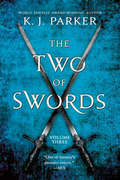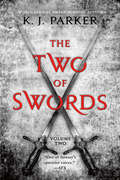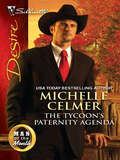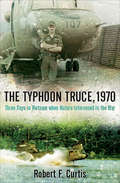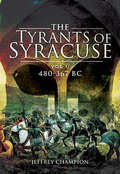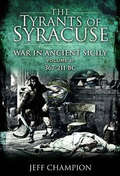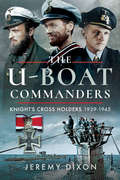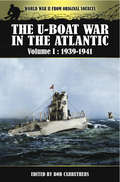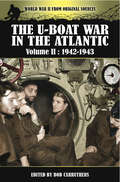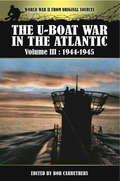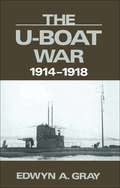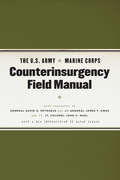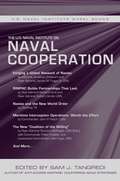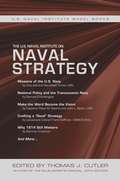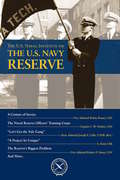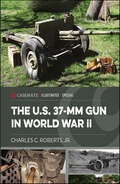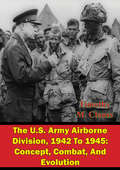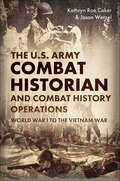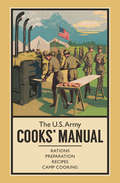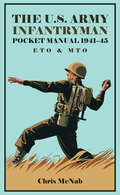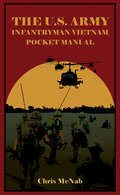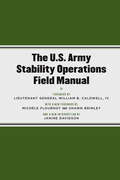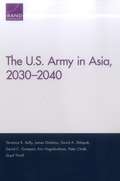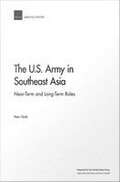- Table View
- List View
The Two of Swords: Volume Three (The Two of Swords #3)
by K. J. ParkerThe epic concluding volume in The Two of Swords trilogy by World Fantasy Award-winning author K. J. Parker."Why are we fighting this war? Because evil must be resisted, and sooner or later there comes a time when men of principle have to make a stand. Because war is good for business and it's better to die on our feet than live on our knees. Because they started it. But at this stage in the proceedings," he added, with a slightly lop-sided grin, "mostly from force of habit."A soldier with a gift for archery. A woman who kills without care. Two brothers, both unbeatable generals, now fighting for opposing armies. No-one in the vast and once glorious United Empire remains untouched by the rift between East and West, and the war has been fought for as long as anyone can remember. Some still survive who know how it was started, but no-one knows how it will end.The Two of Swords is the story of a war on a grand scale, told through the eyes of its soldiers, politicians, victims and heroes.
The Two of Swords: Volume Two (The Two of Swords #2)
by K. J. ParkerThe second volume in The Two of Swords trilogy by World Fantasy Award-winning author K. J. Parker."Why are we fighting this war? Because evil must be resisted, and sooner or later there comes a time when men of principle have to make a stand. Because war is good for business and it's better to die on our feet than live on our knees. Because they started it. But at this stage in the proceedings," he added, with a slightly lop-sided grin, "mostly from force of habit."A soldier with a gift for archery. A woman who kills without care. Two brothers, both unbeatable generals, now fighting for opposing armies. No-one in the vast and once glorious United Empire remains untouched by the rift between East and West, and the war has been fought for as long as anyone can remember. Some still survive who know how it was started, but no-one knows how it will end.The Two of Swords is the story of a war on a grand scale, told through the eyes of its soldiers, politicians, victims and heroes.
The Tycoon and the Townie
by Elizabeth LaneTHE WEALTHY MAN...Struggling single mother Kate Valera had spent most of her life with her nose pressed against the window, looking at how the other half lived. And then one day, she saw Jefferson Parish looking back at her. The wealthy widower was everything she'd always wanted...and known she couldn't have.Jeff touched something in Kate that had lain sleeping for so long, she wasn't sure it was still there. But he was used to a "certain kind of woman," Kate knew, and she-waitress uniform and all-was not exactly it. Was theirs only a summer romance-or would those autumn winds sweep them down the aisle?
The Tycoon's Paternity Agenda: The Tycoon's Paternity Agenda Ultimatum: Marriage Bossman Billionaire Master Of Fortune (Man of the Month #107)
by Michelle CelmerMr. December: Adam Blair, billionaire oil baron.Dream: Producing a much-wanted heir.Dilemma: Keeping the arrangement strictly business.The time had come to move on. CEO and widower Adam Blair was determined to find the right woman to carry his baby. And when Katy Huntly, his late wife's sister, discovered his plan, she demanded to be the surrogate. The agreement certainly made sense...on paper. Adam had always felt a certain pull toward Katy, and those feelings only intensified the closer they grew. But falling in love had no place in this tycoon's agenda. How could he imagine allowing their relationship to progress beyond nine months?
The Typhoon Truce, 1970: Three Days in Vietnam when Nature Intervened in the War
by Robert F. CurtisThis military history chronicles a time during the Vietnam War when fighting stopped and the 101st Airborne helped those in need during a natural disaster. For three days during the Vietnam War, it wasn&’t rockets or artillery that came through the skies, but a horrific force of nature that suddenly put both sides in awe. When Super Typhoon Joan arrived in October 1970, an unofficial truce began. Air crewman faced masses of Vietnamese civilians outside their base perimeters for the first time. Could we trust them not to shoot? Could they trust us not to drop them off in a detention camp? Truces never last, but while they do, life changes for everyone involved. The &“typhoon truce&” stopped the war for three days in northern I Corps—that area bordering the demilitarized zone separating South Vietnam from North. Then, less than a week later, Super Typhoon Kate hit the same area with renewed fury. As the entire countryside was flooded, the people faced war and natural disaster at the same time. No one but the Americans had the resources to help the people who lived in the lowlands, and so they did. The everyday dangers they faced were only magnified by low clouds and poor visibility. But the aircrews of the 101st Airborne went out to help anyway. In this book, we see how, for a brief period during an otherwise vicious war, saving life took precedence over bloody conflict.
The Tyrants of Syracuse Volume I: 480–367 BC (The Tyrants of Syracuse #1)
by Jeff ChampionVolume one of this sweeping history chronicles the turbulent ancient history of Syracuse from the rise of Gelon to the death of Dionysius I. Situated at the heart of the Mediterranean, Syracuse was one of the most important city-states of the classical Greek world. Coveted for its wealth and strategic location, it was caught in the middle as Carthage, Epirus, Athens and then Rome each battled to gain control of the region. The threat of expansionist enemies on all sides made for a tumultuous situation within the city, resulting in repeated coups and a series of remarkable tyrants, such as Gelon, Timoleon and Dionysius. In volume one of The Tyrants of Syracuse, Jeff Champion traces the course of Syracuse's wars from the Battle of Himera against the Carthaginians down to the death of Dionysius I, whose reign proved to be the high tide of the city's power and influence. Within this period, Syracuse heroically defeated the Athenian force that besieged them for more than two years—an event with far-reaching ramifications.
The Tyrants of Syracuse Volume II: War in Ancient Sicily, 367–211 BC (The Tyrants of Syracuse #2)
by Jeff ChampionThis is the story of one of the most important classical cities, Syracuse, and its struggles (both internal and external) for freedom and survival. Situated at the heart of the Mediterranean, Syracuse was caught in the middle as Carthage, Pyrrhus of Epirus, Athens and then Rome battled to gain control of Sicily. The threat of expansionist enemies on all sides made for a tumultuous situation within the city, resulting in repeated coups that threw up a series of remarkable tyrants, such as Gelon, Timoleon and Dionysius. In this first volume Jeff Champion traces the course of Syracuse's wars under the tyrants from the Battle of Himera (480 BC) against the Carthaginians down to the death of Dionysius I (367 BC), whose reign proved to be the high tide of the city's power and influence. One of the highlights along the way is the city's heroic resistance to, and eventual decisive defeat of, the Athenian expeditionary force that besieged them for over two years (415-413 BC), an event with massive ramifications for the Greek world. This is the eventful life story of one of the forgotten major powers of the ancient Mediterranean world.
The U-Boat Commanders: Knight's Cross Holders 1939–1945
by Jeremy DixonThis illustrated WWII reference guide presents detailed profiles of Nazi U-Boat commanders who were awarded the Knight&’s Cross. The Knight&’s Cross—or Ritterkreuz—was one of the highest decorations given for acts of valor among the German armed forces during the Second World War. When a U-boat captain was awarded the decoration, it was source of pride for his entire crew. Sometimes it was even added to the boat&’s insignia. In all, there were 123 recipients. In The U-Boat Commanders, Jeremy Dixon provides a highly illustrated guide to all these men and their wartime service. A detailed text accompanied by almost 200 archive photographs describes the military careers of each U-Boat Commander, including those who received the higher grades of the award. Full details are given of their tours of duty, the operations they took part in, how they won their award, how many ships they sank, and their subsequent careers.
The U-Boat War in the Atlantic, 1939–1941: Volume I: 1939- 1941 (World War Ii From Original Sources Ser.)
by Bob CarruthersFirst in the trilogy that covers WWII submarine warfare in the Atlantic from the German perspective—edited by the Emmy Award-winning historian and author. The U-Boat war is a unique visual record of Hitler&’s infamous submarine fleet and a grim account of those that lived, worked and risked their lives stalking the depths of the Atlantic and Mediterranean seas. This book analyzes the development of the U-boat, the recruitment and training, and reveals how the crews tried to destroy essential Allied supplies across the Atlantic and bring Britain to its knees. Using some 250 rare and unpublished photographs together with detailed captions and accompanying text, the book provides an outstanding insight into the various operations and the claustrophobic existence of the crew, where they lived in cramped and often deplorable conditions. It depicts how this potent force became one of the most dominant German fighting units during World War Two and became such a worry to Allied shipping that even Winston Churchill himself claimed that the &“U-boat peril&” was the only thing that ever really frightened him during the war. On their defeat hung the outcome of the war, and through courageous and determined resistance against overwhelming odds, the Allies eventually inflicted such catastrophic damage on the U-boats that the losses were too great to continue. Of the 38,000 men that went to sea onboard these deadly vessels, only 8,000 were to survive to tell the tale.
The U-Boat War in the Atlantic, 1942–1943: Volume Ii: 1942-1943 (World War Ii From Original Sources Ser.)
by Bob CarruthersThis is the fascinating account, as told from the German perspective, of the Battle of the Atlantic, the longest-running, continuous military campaign in World War II, spanning from 1939 through to Germanys defeat in 1945. At its core was the Allied naval blockade of Germany, which was announced the day after the declaration of war, although it quickly grew to include Germany's counter-blockade. The name "Battle of the Atlantic", was coined by Winston Churchill in 1941 and he famously stated that the U-boats were the only thing that really frightened him. The U-boat war encompassed a campaign that began on the first day of the European war and lasted for six years, involved thousands of ships and stretched over thousands of square miles of ocean, in more than 100 convoy battles and perhaps 1,000 single-ship encounters. In the 68 months of World War II, 2,775 Allied merchant ships were sunk for the loss of 781 U-boats.This is the story of that massive encounter from the German perspective. Published in three volumes, this work was compiled under the supervision of the U.S Navy Department and the British Admiralty by Fregattenkapitan Gunther Hessler. The author, though without previous experience as a writer, had first hand experience of U-boat warfare having commanded a U-boat in 1940 and 1941. For the remainder of the war he was Staff Officer to the Flag Officer commanding U-boats. He had access to German war diaries and other relevant documents concerning U-boat command, and this work based on these many documents, tells the story entirely from the viewpoint of that command. For this reason this work is essential reading for anyone interested in the history of World War II from primary sources and will be of enduring interest to those engaged in attempting to unravel the true nature of submarine warfare in World War II.
The U-Boat War in the Atlantic, 1944–1945: Volume Iii: 1944-1945 (World War Ii From Original Sources Ser.)
by Bob CarruthersThis is the second of three volumes covering the U-boat campaign in the Atlantic during the Second World War.This is the fascinating account, as told from the German perspective, of the Battle of the Atlantic, the longest-running, continuous military campaign in World War II, spanning from 1939 through to Germany's defeat in 1945. At its core was the Allied naval blockade of Germany, which was announced the day after the declaration of war, although it quickly grew to include Germany's counter-blockade. The name "Battle of the Atlantic", was coined by Winston Churchill in 1941 and he famously stated that the U-boats were the only thing that really frightened him. The U-boat war encompassed a campaign that began on the first day of the European war and lasted for six years, involved thousands of ships and stretched over thousands of square miles of ocean, in more than 100 convoy battles and perhaps 1,000 single-ship encounters. In the 68 months of World War II, 2,775 Allied merchant ships were sunk for the loss of 781 U-boats.This is the story of that massive encounter from the German perspective. Published in three volumes, this work was compiled under the supervision of the U.S Navy Department and the British Admiralty by Fregattenkapitan Gunther Hessler. The author, though without previous experience as a writer, had first hand experience of U-boat warfare having commanded a U-boat in 1940 and 1941. For the remainder of the war he was Staff Officer to the Flag Officer commanding U-boats. He had access to German war diaries and other relevant documents concerning U-boat command, and this work based on these many documents, tells the story entirely from the viewpoint of that command. For this reason this work is essential reading for anyone interested in the history of World War II from primary sources and will be of enduring interest to those engaged in attempting to unravel the true nature of submarine warfare in World War II.
The U-Boat War, 1914–1918
by Edwyn GrayA history of Germany&’s usage of submarine warfare during World War I, by the author of Operation Pacific. In 1914, U-Boats were a new and untried weapon, and when such a weapon can bring a mighty empire to the brink of defeat there is a story worth telling. Edwyn Gray&’s The U-Boat War is the history of the Kaiser&’s attempt to destroy the British Empire by a ruthless campaign of unrestricted submarine warfare. It opens with Germany&’s first tentative experiments with the submarines and climaxes with the naval mutiny that helped bring down the Kaiser. In between is a detailed account of a campaign of terror which, by April, 1917, had the British Empire on the verge of surrender. The cost in lives and equipment was staggering. On the German side, 4,894 sailors and 515 officers lost their lives in action; 178 German Submarines were destroyed by the allies; 14 were scuttled and 122 surrendered. According to the most reliable sources, 5,708 ships were destroyed by the U-Boats and 13,333 non-combatants perished in British Ships. World figures for civilian casualties were never released.The U-Boat War is a savage but thrilling account of men fighting for their lives beneath the sea, and of the boats that changed the face of naval warfare.
The U. S. Army / Marine Corps Counterinsurgency Field Manual
by John A. Nagl David H. Petraeus James F. Amos Sarah SewallWhen the U.S. military invaded Iraq, it lacked a common understanding of the problems inherent in counterinsurgency campaigns. It had neither studied them, nor developed doctrine and tactics to deal with them. It is fair to say that in 2003, most Army officers knew more about the U.S. Civil War than they did about counterinsurgency. The U.S. Army / Marine Corps Counterinsurgency Field Manual was written to fill that void. The result of unprecedented collaboration among top U.S. military experts, scholars, and practitioners in the field, the manual espouses an approach to combat that emphasizes constant adaptation and learning, the importance of decentralized decision-making, the need to understand local politics and customs, and the key role of intelligence in winning the support of the population. The manual also emphasizes the paradoxical and often counter-intuitive nature of counterinsurgency operations: sometimes the more you protect your forces, the less secure you are; sometimes the more force you use, the less effective it is; sometimes doing nothing is the best reaction. An new introduction by Sarah Sewall, director of the Carr Center for Human Rights Policy at Harvard's Kennedy School of Government, places the manual in critical and historical perspective, explaining the significance and potential impact of this revolutionary challenge to conventional U.S. military doctrine. An attempt by our military to redefine itself in the aftermath of 9/11 and the new world of international terrorism,The U.S. Army / Marine Corps Counterinsurgency Field Manual will play a vital role in American military campaigns for years to come.
The U. S. Naval Institute On International Naval Cooperation
by Sam TangrediInternational naval cooperation encompasses the interaction of the U. S. Naval Services with the navies and militaries of treaty allies and partners nations in support of mutual defense. In addition, the term can be used to define other bilateral and multilateral defense and diplomatic activities affecting naval affairs, such as international law, rules of engagement, and arms control. Activities in support of mutual defense include bilateral and multilateral exercises, international programs such as cooperative acquisition and foreign military sales, combined training, and efforts towards increased interoperability. This volume presents an introductory discussion and selections from Naval Institute books and articles that concern these and other aspects of international naval cooperation. All naval professionals--without exception--encounter, directly participate, or play a supporting role in naval cooperation. Most apparent roles are those of foreign liaison assignments or service on alliance staffs, such as NATO staffs. But coalition operations have become the norm, and fighting alongside foreign navies is an expected aspect of current and future naval warfare. International military and naval cooperation is a specifically defined element of current U. S. national security strategy and codified in joint and Service doctrine. Obviously, an understanding of the subject is necessary in order to carry out the strategy. As part of the Naval Institute Wheel Book series, International Naval Cooperation is intended to provide a basic familiarization to all aspects of the subject and detailed understanding of relevant recent issues and development. Since there current exists no formal training on the subject for naval professionals--with the exception of certain specialized personnel--the book is designed to bridge the existing gap in knowledge. Such knowledge is as important for sea-going officers and sailors as those serving on staffs--perhaps more so, since it is at sea that cooperation brings practical results. In articles, interviews and speeches, recent Chiefs of Naval Operations have pointed to the need for high levels of pre-operational understanding and trust between allies and naval partners by using the admonition "you cannot surge trust. ” Knowledge of naval cooperative programs is the first step towards being able to build such trust. And this book builds that knowledge.
The U. S. Naval Institute On Naval Strategy: The U. S. Naval Institute Wheel Book Series
by Thomas J. Cutler"Wheel books” were once found in the uniform pockets of virtually all junior officers and many senior petty officers. Each small notebook was unique to the Sailor carrying it, but all had in common a collection of data and wisdom that the individual deemed useful in the effective execution of his or her duties. Often used as a substitute for experience among neophytes and as a portable library of reference information for more experienced personnel, those weathered pages contained everything from the time of the next tide, to leadership hints from a respected chief petty officer, to the color coding of the phone-and-distance line used in underway replenishments. In that same tradition, the Naval Institute has created and aptly named the Wheel Book series, portable libraries culled from USNI’s vast array of information that has accumulated for more than a century. Articles from the Institute’s flagship publication Proceedings are combined with selections from USNI’s oral history program and from Naval Institute Press books to create unique guides on a wide array of relevant professional subjects. Just as the "wheel books” of yesterday served the fleet well, the Naval Institute Wheel Books of today provide supplemental information, pragmatic advice, and cogent analysis on topics important to modern naval professionals. The Dictionary of Modern Strategy and Tactics describes strategy as having "a permanent nature, but an ever-changing character. ” For more than a century, both the nature and the character of this essential discipline have been explored in depth by contributors to the Naval Institute’s magazines, books, and oral histories. Drawing from those powerful resources, this carefully selected collection makes clear why naval strategy has always straddled the boundaries between art and science and why its study and employment are essential components of the sea service profession.
The U. S. Navy Reserve
by Thomas J. CutlerThe U. S. Naval Institute Chronicles series focuses on the relevance of history by exploring topics like significant battles, personalities, and service components. Tapping into the U. S. Naval Institute's robust archives, these carefully selected volumes help readers understand nuanced subjects by providing unique perspectives and some of the best contributions that have helped shape naval thinking over the many decades since the Institute’s founding in 1873. Since its founding 100 years ago, Navy Reserve Sailors have served in every conflict from World War I to the present. The exploits of the U. S. Navy Reserve have many times been chronicled in the pages of Proceedings and Naval History. This edition of Chronicles culls articles and excerpts from that vast library.
The U.S. 37-MM Gun in World War II
by Charles C Roberts"These photos are high-quality and many focus on specific components, further enhancing the value of this book for modelers." — Armorama Developed in response to the 1899 Hague Convention, the 37-mm gun met the restrictions on the size of weapons that could fire explosive shells, yet was also light and lethal enough to be used in battle. After World War I, in which the French Model 1916 37-mm was used extensively, several countries developed or adopted the 37-mm gun. Behind in their development of an antitank gun, the United States relied on the German Pak 36 37-mm design as a basis for development. By the mid 1930s, the US Ordnance Department designed the M3 37-mm gun and M4 carriage resulting in a towed antitank gun, the first antitank gun in the US Army. This gun proved effective at the beginning of World War II, but as German armor protection increased, it could not penetrate the frontal armor of many German tanks and was relegated to lesser roles. However, the gun proved effective against the Japanese tanks and Japanese strong points in the Far East. The US military used the gun on several production and experimental armored vehicles including the M3 Lee Medium Tank, the M3 Stuart Light Tank, the M5 Stuart Light Tank, the M8 Armored Car, the T17E1 Staghound Armored Car and the M3A1E3 Scout Car. The gun was also used on several non-armored vehicles, the P39 Aeracobra, and selected naval vessels. Despite its small size, the US M3 37-mm gun served throughout the war, on many vehicles and performed exactly as designed. Fully illustrated, this is the first complete account of the development and use of the US 37-mm gun in World War II.
The U.S. Army Airborne Division, 1942 To 1945: Concept, Combat, And Evolution
by Timothy M. ClaussIn 1939, the U.S. Army had no formal combat formation capable of reaching the battlefield by air. In response to the success of German airborne operations, the U.S. Army formed a small unit of volunteers which was to experiment with airborne equipment and develop techniques. In the span of six years, the fledgling airborne concept expanded from a small platoon of parachute volunteers into five deployed airborne divisions composed of parachute and glider forces with a formal doctrine.This thesis examines the development of the airborne division through its employment in the Mediterranean and European Theaters of Operation, as these theaters employed four of the five U.S. airborne divisions during World War II. The doctrine, organization, and equipment of the airborne division changed significantly from its inception through the end of WWII. Personal influence, lessons learned from combat, and logistical limitations significantly affected the evolution of the airborne division.
The U.S. Army Combat Historian and Combat History Operations: World War I to the Vietnam War
by Jason Wetzel Kathryn Roe Coker"How is history useful for an operational commander or to soldiers in general? What role does history have for doctrine and training to the U.S. Army as an institution? These are questions this book answers as the authors narrate the development combat historian and the evolving role of combat historians as they develop history into a useful tool for informing training, operations, and doctrine development."—New York Journal of Books In World War I, Major General Pershing proposed the idea of establishing a historical office within the AEF headquarters. The War Department reorganized the General Staff to include a Historical Branch. Evidence shows that soldiers acting as historians went "down range," albeit not into combat. By World War II, the situation had changed—whether S.L.A. Marshall's popping out of a billet in Sibret as a shells exploded on the road; Forrest Pogue's typing "on a little camp desk under an apple tree;" Chester Starr's terrain reconnaissance in the Mediterranean theater, or Ken Hechler's command of a four-man historical team interviewing soldiers at the Remagen Bridge and searching through secret documents—the World War II combat historians were there behind and on the front lines with a notebook in one hand and their carbine in the other hand, ever ready to collect battlefield information. Eight historical service detachments were deployed to Korea. The youngest commander, 1st Lieutenant Bevin Alexander, noted "We were on the front lines the whole time . . . We would interview the people afterwards and create a battle study…." After the Korean War, the duties of the combat historian further evolved as what became the Center of Military History published doctrine about military history detachments (MHDs). As America’s immersion in Vietnam escalated, there was concern regarding historical coverage. Chief of Military History Brigadier General Hal Pattison established a network of historical teams to collect information on the U.S Army in the war. A major development in the history program and in deploying MHDs came with the establishment of Headquarters, U.S. Army Vietnam (USARV) under General William C. Westmoreland’s command. In 1965, the history office was organized at Headquarters, U.S. Army Vietnam (USARV). MHDs were deployed across Vietnam, conducting combat after action interviews, and collecting documents. This study focuses on U.S. Army historical programs during combat operations from World War I to the Vietnam War with particular attention on the combat historians, those individuals deployed to a theater of war with the mission of documenting the actions of that theater for current and future historical use.
The U.S. Army Cooks' Manual: Rations, Preparation, Recipes, Camp Cooking (The Pocket Manual Series)
by R. SheppardThis compendium of US Army cooking manuals features recipes, camp cooking tips, and more from the Revolutionary War to WWI. This collection of excerpts from US Army cooking manuals illustrates how America fed its troops from the late eighteenth century to the early twentieth, offering a glimpse of what daily life was like for those preparing and consuming the rations. With an introduction explaining the historical background, this is a fascinating and fun exploration of American army cooking, with a dash of inspiration for feeding your own army! Beginning with a manual from 1775, you will learn how the Continental Congress kept its Patriot forces fed. A manual from 1896 prepares Army cooks for any eventuality—whether in the garrison, in the field, or on the march—with instructions on everything from butchery and preserving meat to organizing food service and cleaning utensils. Along with classic American fare such as chowder, hash, and pancakes, it also includes recipes for Crimean kebabs, Turkish pilau, and tamales. In contrast, a 1916 manual offers a detailed consideration of nutrition and what must be one of the first calorie counters. Instructions are given on how to assemble a field range in a trench or on a train. Among the more unusual recipes are head cheese—meat stew made from scraps—and pickled pigsfeet. Later manuals produced during WWI include baking recipes for breads and cakes, as well as how to cook dehydrated products. &“Culinary and military historians will equally find this a valuable resource.&” —Booklist
The U.S. Army Infantryman Pocket Manual 1941–45: ETO & MTO (The\pocket Manual Ser.)
by Chris McNabPresents information from a wealth of contemporary World War II training manuals and tactical documents. The battle for Europe in 1943–45 was one of the greatest military challenges in the history of the U.S. Army. Fighting against often veteran German forces from the mountains of Italy to the beaches of Normandy and the frozen forests of the Ardennes, hundreds of thousands of US infantrymen had to move quickly beyond their training and acquire real-world combat skills with extraordinary pace if they were to raise their chances of survival beyond a few days. They fought in an age of total war, in which the enemy deployed heavy armor, artillery, air power, and their own infantry firepower in a battle of true equals. Without the drive and blood of the U.S. Army infantry, the Allies could not have defeated the Wehrmacht in Western Europe. Extensive documentation was provided for the in-theater US Army infantryman, from booklets rather misguidedly advising on how to behave in foreign countries through to field manuals explaining core combat tactics across squad, platoon, company, and battalion levels. This pocket manual presents critical insights from many of these sources, but also draws on a broad spectrum of intelligence reports, after-action reports, and other rare publications. Together they give an inside view on what it was like to live and fight in the U.S. Army infantry during arguably the most consequential conflict in human history.
The U.S. Army Infantryman Vietnam Pocket Manual (The\pocket Manual Ser.)
by Chris McNabPocket manuals bring together a wealth of information from a wide variety of training manuals and tactical documents. Between 1964 and 1975, 2.6 million American personnel served within the borders of South Vietnam during the Vietnam War, of whom an estimated 1–1.6 million actually fought in combat. At the tip of the spear was the infantry, the "grunts" who entered an extraordinary tropical combat zone completely alien to the world they had left behind in the United States. In South Vietnam, and occasionally spilling over into neighboring Laos and Cambodia, they fought a relentless counterinsurgency and conventional war against the North Vietnamese Army (NVA) and Viet Cong (VC). The terrain was as challenging as the enemy – soaring mountains or jungle-choked valleys; bleached, sandy coastal zones; major urban centers; riverine districts. Their opponents fought them with relentless and terrible ingenuity with ambushes, booby traps, and mines, then occasionally with full-force offensives on a scale to rival the campaigns of World War II. This pocket manual draws its content not only from essential U.S. military field manuals of the Vietnam era, but also a vast collection of declassified primary documents, including rare after-action reports, intelligence analysis, firsthand accounts, and combat studies. Through these documents the pocket manual provides a deep insight into what it was like for infantry to live, survive, and fight in Vietnam, whether conducting a major airmobile search-and-destroy operation or conducting endless hot and humid small-unit patrols from jungle firebases. The book includes infantry intelligence documents about the NVA and VC threats, plus chapters explaining hard-won lessons about using weaponry, surviving and moving through the jungle, tactical maneuvers, and applications of the ubiquitous helicopter for combat and support.
The U.S. Army Stability Operations Field Manual: U.S. Army Field Manual No. 3-07
by Caldwell Iv William Flournoy Michele Brimley Shawn Davidson JanineField Manual 3-07,Stability Operations, represents a milestone in Army doctrine. With a focus on transforming conflict, managing violence when it does occur and maintaining stable peace,The U. S. Army Stability Operations Field Manual(otherwise known as FM 3-07) signals a stark departure from traditional military doctrine. The Army officially acknowledges the complex continuum from conflict to peace, outlines the military's responsibility to provide stability and security, and recognizes the necessity of collaboration, coordination, and cooperation among military, state, commercial, and non-government organizations in nation-building efforts. The manual reflects a truly unique collaboration between the Army and a wide array of experts from hundreds of groups across the United States Government, the intergovernmental and non-governmental communities, America's allies around the world, and the private sector. All branches of the armed forces, U. S. agencies ranging from the State Department to Homeland Security to Health and Human Services, international agencies from the United Nations to the Red Cross to the World Bank, countries from the United Kingdom to India to South Africa, private think tanks from RAND to the United States Institute of Peace to the Center for New American Security, all took part in the shaping of this document. The U. S. Army Stability Operations FieldManual,marks just the second time in modern history that the U. S. Army has worked with a private publisher to produce a military doctrinal document. Lieutenant General William B. Caldwell, IV is Commander of the Combined Arms Center at Fort Leavenworth, Kansas. Michèle Flournoy, Under Secretary of Defense for Policy Shawn Brimley, Fellow, Center for a New American Security Janine Davidson, Deputy Assistant Secretary of Defense for Plans "It is a roadmap from conflict to peace, a practical guidebook for adaptive, creative leadership at a critical time in our history. It institutionalizes the hard-won lessons of the past while charting a path for tomorrow. This manual postures our military forces for the challenges of an uncertain future, an era of persistent conflict where the unflagging bravery of our Soldiers will continue to carry the banner of freedom, hope, and opportunity to the people of the world. " -From the foreword by Lieutenant General William B. Caldwell, IV, Commander of the Combined Arms Center at Fort Leavenworth, Kansas
The U.S. Army in Asia, 2030-2040
by James Dobbins Peter Chalk David C. Gompert Terrence K. Kelly Eric Heginbotham David A. Shlapak Lloyd ThrallLooking to the 2030-2040 time frame, U. S. policy and military strategy will need to strike a balance among maintaining a cooperative relationship with China, deterring Chinese aggression in regional disputes, and preparing for the possibility that China could become more assertive. The U. S. Army will have an important role to play in preparing for these developments and for protecting and furthering U. S. interests in the region.
The U.S. Army in Southeast Asia: Near-Term and Long-Term Roles
by Peter ChalkThis RAND report examines the U.S. Army role in Southeast Asia. Under current benign conditions, efforts should focus on supporting defense reform, addressing transnational threats, and balancing China. If the outlook deteriorates, the United States should increase security cooperation, conclude new regional basing agreements, expand disaster assistance, and create policies to encourage risk-averse Chinese behavior.
